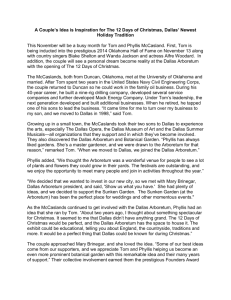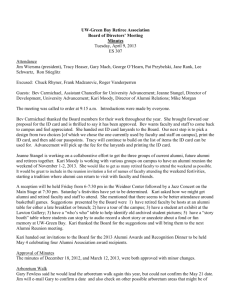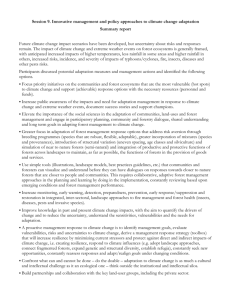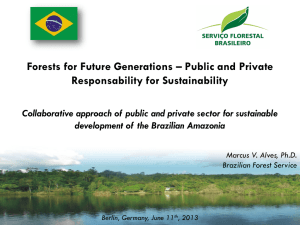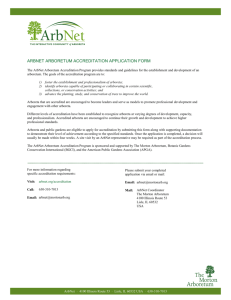Living Collections Policy - National Arboretum Canberra
advertisement
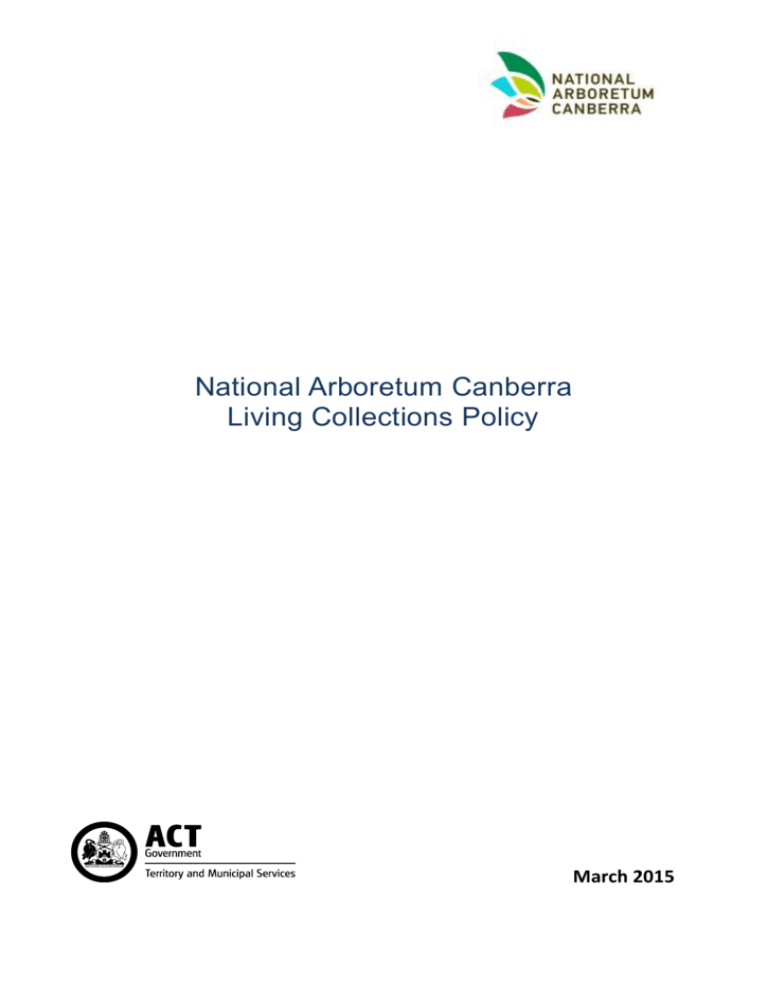
National Arboretum Canberra Living Collections Policy March 2015 Contents 1 Introduction ................................................................................................................................... 1 2 Purpose of the living collection ..................................................................................................... 1 3 Collection governance ................................................................................................................... 2 4 Design intent.................................................................................................................................. 2 5 Plant records system ..................................................................................................................... 2 5.1 Forest and ceremonial plantings ......................................................................................... 2 5.2 Minimum information required .......................................................................................... 3 5.3 Bonsai .................................................................................................................................. 3 6 Acquisition ..................................................................................................................................... 3 7 Legal and ethical considerations ................................................................................................... 4 8 Donations and gifts ........................................................................................................................ 4 9 Care of the collection..................................................................................................................... 4 9.1 Tree removal and replacement ........................................................................................... 5 9.2 Management of failed forests ............................................................................................. 5 9.3 Pruning regimes................................................................................................................... 5 9.4 Biosecurity risk management .............................................................................................. 5 9.5 Pest, disease and weed control ........................................................................................... 6 9.6 Management of vertebrate pests ....................................................................................... 6 9.7 Irrigation and fertilising ....................................................................................................... 6 10 Deaccessioning and disposal ......................................................................................................... 6 11 Research and conservation............................................................................................................ 7 12 Access to collections ...................................................................................................................... 7 13 Review ........................................................................................................................................... 7 1 Introduction This Living Collections Policy determines management of all plants cultivated at the National Arboretum Canberra (NAC) including forests, the National Bonsai and Penjing Collection of Australia (NBPCA), the Canberra Discovery Garden (CDG) and the Southern Tablelands Ecosystems Park (STEP). In addition, a 70 hectare patch of yellow box woodland (known as patch GG) adjoins the 250 hectare site and is managed by the ACT Parks and Conservation Service in consultation with the Arboretum. These forests, gardens and remnant bushland areas represent a diverse selection of exotic and native flora. Decisions that determine the development and management of the living collection are guided by the Arboretum’s mission to ‘create and nurture a living collection of forests of international significance, for recreation, education and conservation’. This policy defines strategic and operational guidelines used to achieve these objectives. Precise details about the various collections are outlined in detailed management plans produced for each forest and garden: G:\National Arboretum\FOREST MANAGEMENT\Forest Management Guidelines June 13.doc 2 Purpose of the living collection Forests The National Arboretum Canberra cultivates forests and gardens that display rare, threatened and symbolic species from around the world. Each individual forest and garden forms part of the Arboretum’s vision to be ‘an internationally recognised Arboretum of outstanding beauty, community amenity and scientific value’. With this in mind, the purpose of the collections can be divided into three core groups for interpretation: Conservation – a collection of plants developed in line with international, national or local conservation plans for the ex situ protection of plant biodiversity, highlighting rare and threatened species and remnant vegetation. Cultural importance – a collection of plants which have symbolic, historic and/or social values. Geographic – a collection of plants from a defined geographic area or country. Note: some collections will be present in more than one of these core groups. Please refer to information on our website, which outlines details of each species and/or collection: http://www.nationalarboretum.act.gov.au/living-collection/trees/tree-descriptions Bonsai and Penjing Collection The following criteria determine the selection of Bonsai and Penjing specimens: Geographic – a collection that displays 100 of the best Bonsai and Penjing specimens in Australia. Artistic – the collection displays a diverse range of species. Individual trees display the best possible examples of each species showcasing the talent, skill and style of each artist. Further information can be found online at: http://www.nationalarboretum.act.gov.au/living-collection/bonsai/about-bonsai-and-penjing 1 3 Collection governance Overall responsibility for management of the Arboretum rests with the Executive Manager, with strategic direction and delegated approvals provided through the Executive Director, Parks and City Services, Territory and Municipal Services Directorate, ACT Government. The Executive Manager will seek input from the Forest Management Advisory Committee (FMAC) and the (NBPCA) Collection Advisory Committee (CAC) as required. Stakeholders including the Australian National University, Icon Water and STEP will provide input as part of the FMAC. The Terms of Reference for the FMAC are at Error! Reference source not found.. Day to day operational management of the Living Collection is delegated to the Operations Manager, who manages horticultural staff, facilities staff, horticultural contractors and budget allocation. Annual and monthly operational plans are to be developed to guide resource allocation and priority setting. The annual plan will be approved by the Executive Manager. 4 Design intent The overall master plan and the design concept developed by landscape architects Taylor Cullity Lethlean outline the establishment of 100 forests of rare, threatened and symbolic trees from around the world. The combination of design elements that make the Arboretum unique are to be considered in future plans for forest plantings, community amenity and interpretation. These design elements are: Monoculture forest design – traditionally, arboreta display individual specimens or small groups of each species. The design master plan sets the National Arboretum Canberra apart. Monoculture forests display single species planted on mass in numbers ranging from 35 to nearly 2000 trees. Each forest has been designed to provide an immersive experience for the visitor. This can be seen in and was inspired by mature plantings of Himalayan Cedars and Cork Oaks. Diversity of form, colour and texture – the overall design exhibits a patchwork of contrasting textures and colours featuring coniferous, deciduous, palmiferous and evergreen trees. Each species adheres to established criteria (refer to section 6. ‘Acquisitions’). Planting patterns – some of these dictate management requirements. Removal of trees and replanting is to be done in a way that adheres to individual forest designs so as not to significantly alter existing patterns. Landscape design – central valley and terraces, use of Walter Burley Griffin axis. Ceremonial plantings in the Central Valley and Events terrace areas are to be in keeping with the Arboretum Master plan. 5 Plant records system 5.1 Forest and ceremonial plantings The Arboretum will utilise the existing TAMS Geographic Information System (GIS) and other asset management systems as the basis for accessioning and plant record keeping of the Living Collection (excluding NBPCA). This guarantees that the system will be compatible and consistent with other TAMS management systems and processes will have the required level of corporate support and thus will be sustainable in to the future. 2 All trees are to be accessioned. Shrubs, grasses and annuals will not be accessioned, however, this may be considered as part of the next policy review. Information pertinent to the provenance of each tree is also to be recorded using TAMS GIS. For guidelines relating to information required for new plantings refer to section 6. ‘Acquisitions’. Plant records entered into the system will be used for interpretation, research, education and to collaborate with other arboreta and gardens. They will also be used to maintain and improve horticultural management of each forest and the Arboretum as a whole. Plant classification questions of a technical nature will be addressed to an acknowledged taxonomic authority through the FMAC. Provision of information pertaining to planned (and actual) installations of new individual trees is the responsibility of those supervising the project. Information pertaining to the status of an accessioned item (e.g. change of location, death, removal) and oversight of the plants record system is the responsibility of the Operations Manager. Information on new plants is to be entered with four weeks of the plants installation or four weeks after Works As Executed (WAE) information has been received. Changes in the status of an accessioned item must be noted as soon as possible after the status change has taken place. 5.2 Minimum information required Information pertinent to the accession’s taxonomic classification, provenance, source, date of acquisition, date planted, and mapped location are to be kept on all trees in the Living Collection. Voucher specimens will also be kept at the Australian National Herbarium for identification, with an additional set kept in folders at the Arboretum for reference. 5.3 Bonsai Data Management of the NBPCA specimens will be undertaken through a bespoke system managed by the Curator, NBPCA, in consultation with the CAC. This system recognises that the NBPCA does not require a spatial approach to data collection and management. NBPCA will provide access to all data. 6 Acquisition Most of the forests have already been planted and there remains only a small number to be established. These are shown on the Arboretum forest planting map. The forest planting map and Arboretum infrastructure Master Plan must be considered before plant acquisitions are made to ensure the choice of species, and their location aligns with planned and potential future infrastructure listed in the Infrastructure Plan. Species are to be selected as per the Arboretum design master plan. This plan may be varied or altered only with appropriate consultation. If for any reason a particular species cannot be obtained an alternate species is to be selected against the following criteria: Conservation value, cultural value or geographic significance. Refer to section 2 ‘Purpose of Collection’. Provenance of plant material which may include seed, cutting material, tissue culture material or nursery stock. Species chosen must be suitable for known, local climatic and growing conditions. 3 Any new acquisitions must have been assessed for their ‘weediness’ to ensure that the Arboretum doesn’t inadvertently introduce a plant pest. Plant material being imported to site must meet AQIS conditions and be free from pests, diseases and weeds. Recommendations for acquisition to the collection may be received from any source including staff, volunteers, Arboretum advisory committees or members of the public and should be submitted in writing to the Executive Manager. Recommendations will be considered taking into account the Arboretum Master Plan, Infrastructure Plan, the species selection process and provenance of plant material. Purchase of trees must be approved by Operations Manager. Upon approval of a forest planting a project plan is to be provided by the projects supervisor which outlines timing of propagation and/or acquisition. Acquisitions for the purpose of replanting can be undertaken by horticulture staff responsible for their care so long as funding is available and a purchase order with all relevant details is provided for approval. Acquisition of displays for the NBPCA is managed by its curator aided by the NBPCA Selection Advisory Committee (SAC). 7 Legal and ethical considerations The National Arboretum Canberra is committed to adhering to all laws, regulations and codes of practice be they local or federal in scope which govern environmental impact, quarantine, biosecurity, heritage protection or endangered species conservation. This includes recognition of Plant Breeders Rights (PBR) and other intellectual property rights. The Arboretum is also committed to taking a proactive approach in providing high levels of accessibility to the living collection for all visitors and stakeholders. 8 Donations and gifts All potential plant acquisitions presented to the Arboretum as gifts are subject to the same selection criteria as outlined for acquisitions in general and are to be approved by the FMAC or SAC as appropriate. The Arboretum reserves the right to display, not display or return an acquired gift. The Arboretum will not appraise any gifts or donations to the collection as to value. The Arboretum’s Gift Policy will be considered when evaluating potential gifted acquisitions. 9 Care of the collection The living collections of the National Arboretum Canberra are to be maintained in good health and in accordance with industry best practice. It should also be noted that maintenance is carried out by contractors as per the horticultural maintenance contract. Whilst this policy guides management of the Living Collection, it is imperative that decisions made do not contradict terms in the contract to allow for efficient delivery of those services. A risk management approach will be taken to manage risks such as disease and wildfire. 4 9.1 Tree removal and replacement Any plants that require removal or replacement due to death or decline are to be reported by the end of each month to the Operations Manager for assessment. Following an assessment of the nominated specimens, the Operations Manager will schedule the replacement of the plant or organise remedial horticultural work if required. Replants are to be carried out by the end of the following month, with the exception of forests that have sustained losses above ten percent before the introduction of this policy, in that instance an assessment is to be made as per section 9.2. ‘Management of failed forests’ If nursery stock is not available for re-planting a plan for sourcing and/or propagating suitable plant material must be provided by the Operations Manager within 14 days. 9.2 Management of failed forests In circumstances where there are losses above ten percent and/or losses dictate that the forest species is no longer viable, an investigation is to be undertaken by the Operations Manager. The Operations Manager will then provide a written report to the Executive Manager and FMAC. Assessment reports are to provide the following information: reason/s for tree losses, testing carried out (where applicable), removal plan and replacement plan, alternate species (where applicable) and a cost estimate and timeline for proposed works. Recommendations must be approved by the Executive Manager before they are actioned. 9.3 Pruning regimes It is the responsibility of the Operations Manager to oversee all pruning at the National Arboretum Canberra. All pruning must be exemplary and follow the Australian Standard for Pruning of Amenity Trees (AS 4373-2007). All pruning shall have a clear objective whether formative, for safety, health or aesthetics. This includes the practice of thinning forests. Proposals to ‘thin’ forests in order to improve the overall health and development of that forest are to be submitted in writing to the Operations Manager for approval by the Executive Manager General maintenance pruning does not require approval providing it adheres to the standards mentioned above. Guidelines for pruning of individual forest species are outlined in the ‘Forest Maintenance Guidelines’ document. 9.4 Biosecurity risk management Biosecurity relevant to the Arboretum can be defined as the protection of flora from the introduction of exotic pests (insects, diseases, weeds and other biological organisms) that may adversely impact the asset. Given the monoculture design of the Arboretum, any introduced exotic pests have potential to establish quickly on their plant host. For this reason, early detection is paramount and forests are to be regularly monitored for any potential pest problems. Plant Health Australia (PHA) and Nursery Garden Industry Australia (NGIA) provide up to date advice on notification and treatment of plant pests. Notifiable pests are to be reported by the Operations Manager to the Exotic Plant Pest Hotline on 1800 084 881. Plant material brought on to site must be purchased from industry regulated growers and inspected for pests, diseases and weeds before being delivered to the Arboretum. Imported seeds and other plant material must adhere to current AQIS conditions and be permitted for import into Australia, accompanied by a phytosanitary certificate as per regulations and be treated in consultation with AQIS if required. The complete set of import conditions for each species is available at www.aqis.gov.au 5 9.5 Pest, disease and weed control Weeds are to be controlled as per the ACT Weeds Strategy 2009-2019 as amended from time to time. Rocky outcrops containing plant pests are to be maintained, as resources allow, with the focus being on retention of local native species and slashing of weeds before flowering where possible to reduce seed dispersal. An integrated pest, disease and weed management approach will be adopted to minimise use of chemical controls. The Arboretum will not utilise neonictinoid pesticides or residual herbicides. Common plant pests and diseases that do not pose a biosecurity risk are to be regularly monitored by NAC horticultural staff.NAC horticulture managers, staff and stakeholders are to cooperate with neighbouring land managers as required to reduce the spread of pests, diseases or weeds in the local area. 9.6 Management of vertebrate pests Vertebrate pests are to be managed as per territory legislation and in cooperation with adjoining landholders. NAC will up hold a zero tolerance approach to new incursions of vertebrate pests such as pigs, rabbits and deer and will monitor population of all exotic and native pests. Damage to the living collection as a result of stock from neighbouring properties is to be rectified by the landholder in consultation with NAC. NAC will make reasonable efforts to inform stakeholders and protect and return stock that has inadvertently strayed onto NAC property. 9.7 Irrigation and fertilising Irrigation will be provided to establish and maintain optimal tree health and vigour. Trees species that no longer require regular irrigation in addition to rainfall are to be gradually weaned off so as not to disrupt root development. It is noted, that water needs vary significantly for each species, however, irrigation records, weather records and meter readings are to be used as a guide to inform scheduling. The Arboretum’s horticultural management philosophy is to encourage good soil health in order to optimise the effectiveness of fertilisers. For this reason, products that restore beneficial microorganisms are used. 10 Deaccessioning and disposal Deaccessioning and disposal of dead or dangerous plants is to be approved by the Operations Manager. A report summarising losses is to be submitted to the FMAC by the Operations Manager within one month of removal of the plant. Requests to remove or relocate living plants are to be submitted in writing to the Operations Manager for approval. Should a tree planted under the Ceremonial Tree Planting policy fail the relevant embassy, office for the head of government or celebrity will be informed through the appropriate protocol channels of the ACT Government, to seek the views of the dignitary/donor as to its replacement. All deaccessions are to be recorded by the Operations Manager. This information is to include date, species, location of tree, reason for disposal and method of disposal. 6 11 Research and conservation The National Arboretum supports and encourages use of the living collection for scientific research and conservation. Requests to undertake research or conservation projects at the Arboretum are to be reviewed by the Research Coordination Committee and approved by the Executive Manager. Trials, both in house or by other organisations, are actively encouraged in order to learn more about individual forest and species. For example, the results of propagation trials of rare species to assist their continued survival or representation can be shared with other arboreta and gardens. There is also opportunity to conduct trials in consultation or partnership with commercial suppliers, providing procurement processes meet ACT Government guidelines (for example, fertiliser trials). Study may also include cultural, social and artistic observation, display or other interaction that relates to the living collection. For example, the Arboretum may be used to inspire artwork, botanical illustration for documentation, musical composition and performance, history and use of plants whether they be indigenous or exotic. 12 Access to collections The National Arboretum Canberra grounds are open to the public. Public use and access provisions are described in the Public Use Policy at http://www.nationalarboretum.act.gov.au/visit/public-usepolicy. Requests for information on the living collection are to be directed to the Operations Manager in the first instance. Requests to access, remove or exchange plant material require approval from the Executive Manager and can be made in writing by members of the public, staff, volunteers, stakeholders, community and commercial enterprises. A ‘release of plant material’ request form (Error! Reference source not found.) is to be filled out and submitted to the Operations Manager. Plant material includes leaves, flowers, fruits seeds and bark, harvesting of any plant material is subject to the approval process mentioned above. Horticultural staff are required to keep a calendar of approximate harvesting times which is to be updated by the end of each month Note that in circumstances where removing the material would be detrimental to the collection approval will not be granted. This particularly applies to removal of plant material from rare or threatened species. It should be recognised that seed, particularly that which is rare, has commercial value. A nominal fee will charged to cover the cost of administering release of plant material. In circumstances where use of the material is a commercial enterprise charges will be determined accordingly. Permission must be sought if the recipient seeks to commercialise either the genetic material, its products, or research derived from it. Genetic material, its products, or research derived from it may not be passed to a third party for commercialisation without permission from the NAC. Arboreta, gardens and growers using material for propagation or export are responsible for all relevant quarantine requirements. Publications resulting from the use of the plant material supplied by the NAC must acknowledge NAC as the supplier. 13 Review This policy will be reviewed at least every five years or sooner upon considering advice from the FMAC, NBPACA or CAC. 7 ATTACHMENT B i


